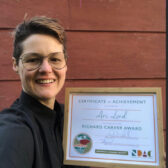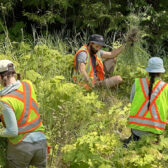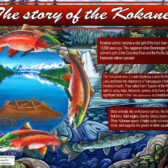The 'F' word in our trash
By Michael Jessen
It sustains human life, but it’s becoming the stuff of our trash.
Food is four-letter word beginning with an “F.” What’s unsavoury, gross and embarrassing is the amount of food that Canadians waste.
The George Morris Centre – an independent agri-food think-tank based in Guelph, Ont. – recently released a report from its Value Chain Management Centre with alarming and grim news.
We Canadians waste an estimated $27 billion worth of food annually, equal to approximately 40 per cent of all the food we produce and two per cent of Canada’s gross domestic product.
Just over half of that waste – 51 per cent – worth an estimated $13.4 billion, is coming from home kitchens, says the study Food Waste in Canada. Statistics Canada estimated in 2007 the loss of solid food between retail and the plate at more than six million tonnes – the equivalent of 183 kilograms per person.
Food packagers and processors account for 18 per cent of the food waste and retail stores waste 11 per cent. Nine per cent is wasted in farmer’s fields, eight per cent in hotel, restaurant and institutional food outlets. Only three per cent is wasted during transportation and distribution.
Food Waste in Canada blames poor management all through the food chain from the farm to the table for the high amount of food waste, but makes an interesting comment on consumer behaviour.
The report says Canadian retailers are unique in the extent to which they rely on price-oriented fliers as a primary marketing tool.
“Fliers have the potential to encourage consumers to seek out deals and buy beyond their needs,” the authors write. “An almost invariable outcome of this is that consumers place an overly high importance on price and buying in bulk, which then leads to increased waste.”
When that food waste needlessly fills up our landfills, it doesn’t harmlessly decompose but creates methane, a gas 25 times more damaging to Earth’s atmosphere than carbon dioxide.
And it is not just the food that is being wasted – think about the energy, water, packaging and human resources used in production, transportation, retailing, food service and home storage of that food.
Coming at a time when the United Nations food agency (FAO) is revealing that food prices are hitting record highs, this report should act as a wakeup call to everyone along the food chain.
The FAO said sugar and meat were at their highest since its records began in 1990. Prices were at their highest since 2008 crisis levels for wheat, rice, corn and other cereals. The cost of food rose 11.7 per cent in the year 2010 to November, while non-food items were up just 1.9 per cent, according to FAO statistics.
Jonathan Bloom, author of American Wasteland: How America Throws Away Nearly Half of Its Food (and What We Can Do About It), says Americans waste enough food every day to fill the Rose Bowl. Food waste today is 50 per cent higher than in 1974, according to Bloom.
Fossil fuels are a major component of growing, processing, transporting and refrigerating food, and the price of a barrel of oil is once again creeping up to the $100 mark (you probably noticed the recent six cent jump in the price of a litre of gas at the pumps in Nelson).
A recent study from the University of Texas at Austin by professors Amanda D. Cuellar and Michael E. Webber found that two per cent of all U.S. energy consumption goes into producing food that is ultimately thrown out.
“That’s the equivalent of 350 million barrels of oil,” writes Bloom. “To give you a sense of perspective, every year, through uneaten food, we waste 70 times the amount of oil that gushed into the Gulf of Mexico during the three months of the Deepwater Horizon spill.”
Bloom says Americans are wasting more than 100 billion pounds of food at an estimated financial cost of $150 billion.
“The average family of four, conservatively, throws out an estimated $1,350 annually,” he writes.
Cutting food waste will not only help the planet, but make you a more ethical person. Bloom offers the following tips for helping eliminate food waste:
• Plan meals before shopping, taking stock of what you already have and whether you’ll have the time or inclination to cook.
• Make a detailed grocery list and stick to it, avoiding impulse buys.
• Serve reasonable portions, knowing family or guests can always take seconds.
• Save (and eat) those leftovers. You are saving food, not performing science projects. Simply discarding an item two weeks later does no good.
• Compost. It isn’t hard, and there are even machines that allow those without backyards to compost indoors.
• Ah, composting – when between 30 and 40 per cent of the waste going to our landfills is compostable, it makes you wonder why there isn’t more education to home compost or a pickup service to take this component out of the waste stream.
Closer to home
A while back, Earth Matters in Nelson operated a bicycle-powered pickup service that serviced some area restaurants. A program of the Nelson CARES Society, Earth Matters has been planning for a number of years a social enterprise endeavour funded by Enterprising Non-Profits (full disclosure: I participated on a committee helping plan this project).
The business will provide compost pickup service to all Nelson residents as well as providing the finished compost for sale. A mechanized facility will be constructed that will aerate the piles and increase the rate of microbial activity, taking only four weeks to transform from food waste to usable soil. The business aims to employ youth and persons with disabilities where ever possible.
A number of years ago, Raymond Gaudart – the former waste reduction coordinator for the Kootenay Boundary Regional District – tried without success to get the Regional District of Central Kootenay to join in the construction of a large, centrally-located composting plant.
Gaudart was motivated by a report done by Footprint Environmental Strategies and Western BioResources that found almost 40 per cent of landfilled waste was compostable organics.
“If this waste is diverted from landfill, the useful life of our current landfills would be extended by 349 years and landfill closure costs may be reduced by almost 50 per cent,” said the report.
Landfill closure costs would require an investment of $2.3 million in 2004 dollars earning six per cent interest, said the consultants.
“If we remove organics from the landfill and only $275,000 would have to be invested,” the consultants wrote.
With food prices rising, perhaps we will all be motivated to reduce our food waste. But the rising price of waste disposal and the methane threats posed by our landfills should also motivate us to seek better solutions than burying organic material.
We may never be able to totally eliminate food waste, but it is time to put a big dent in the problem.
Resources
The Food Waste in Canada report is available at http://www.vcmtools.ca/pdf/Food%20Waste%20in%20Canada%20120910.pdf.
American Wasteland is published by Da Capo Press and is available in hardcover for $32.95. Jonathan Bloom has a website at http://www.wastedfood.com/.
The Cuellar and Webber study referred to by Bloom can be found at http://pubs.acs.org/doi/pdf/10.1021/es100310d.
Earth Matters has a website at http://earthmatters.ca/.
The British website http://www.lovefoodhatewaste.com/ has some great tips for reducing food waste, including recipes for leftovers.
Two excellent websites for composting newbies and veterans are http://www.howtocompost.org/ and http://compostguide.com/.
Research estimates that 8.3 million tonnes per year of food and drink waste is generated by households in the United Kingdom. A report about the factors influencing food waste and improving consumer understanding and knowledge about the issue is available at http://www.wrap.org.uk/retail_supply_chain/research_tools/research/report_helping.html.

























